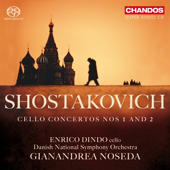
ESSENTIAL RECORDINGS

In his wonderful book The Infinite Variety of Music, Leonard Bernstein essays to explain and describe the infinite variety of music based on the 12 notes of
the scale system. To simplify matters, he points out a multitude of examples where various composers, using exactly the same 4 notes as the initial protagonists of a motif
or theme, have been led down completely divergent directions based on those same 4 notes. In his Cello Concerto No. 1 in E-flat Major, Op. 107,
composer Dmitri Shostakovich (1906-1975), reinforces this by quite literally building a complex four movement work on a 4 note foundation. The first
movement in particular is a prime example of how a proficient composer can build a solid edifice using only 4 notes as its foundation. This concerto is also a perfect
vehicle for the cellist, demanding the utmost in versatility, from the nimble finger work of the outer movements, to the lyrical intensity of the slow movement, to the extended
and taxing soliloquy of the Cadenza movement. Cellist Enrico Dindo has only released a couple of recordings thus far and may not be a
familiar name to many, but this new recording should turn the focus of attention in his direction. Not only does he manage to execute the aforementioned demands like a
veteran of the stage, but he also adds much of himself to the music and generates a sound with a quality that is warm, sharp and sardonic all rolled into one. The members
of the Danish National Symphony Orchestra along with Enrico Dindo, expose this work's dual personality better than most, from
its profound lyricism to its trenchant musical sarcasm.
And now for a complete about face. The enigmatic Cello Concerto No. 2, Op. 126. In the words of Mstislav Rostropovich, the dedicatee of
both concertos, 'its profundity is second to none'. The cello does not simply play a function in this one, now the cello is the music, now the cello is
the vehicle for the unfolding musical narrative. The orchestral parts are written around the cello, rather than it being written into the orchestral fabric. Enrico Dindo
lives the part, becomes the medium through which the music speaks, and compels the cello to breathe and be the music. In this work,
the cello is an extension of Shostakovich himself, allowing him to speak freely and openly without fear of reprisal. Unless the interpreter feels and conveys this, the point
of the work fails. This is an aspect that both Enrico Dindo and conductor Gianandrea Noseda have nailed down. They bring out
the essence, the raison d'Ítre of this controversial and haunting piece of music like no one else.
As always, Chandos have produced a spacious and yet intimate recording with the perfect perspective on both the cello and orchestra, and have
captured the other main players, the bassoon, the principal horn, and the wood blocks, in just the right light.
Jean-Yves Duperron - February 2012